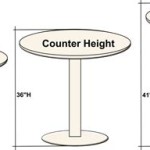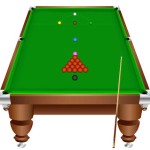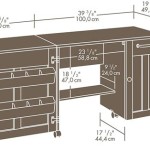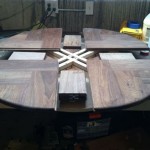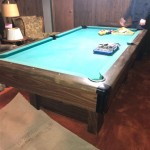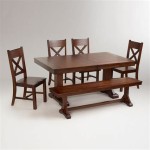How Tall Should a Table Lamp Be?
Determining the appropriate height for a table lamp is crucial for both aesthetics and functionality in interior design. A well-chosen lamp height can significantly enhance the visual appeal of a space while simultaneously providing optimal illumination for various tasks and activities. This article will explore the factors influencing the ideal table lamp height and provide guidance on selecting the right lamp size for different furniture types and room settings.
The primary consideration when selecting a table lamp is its intended function. Is it meant to provide ambient lighting, task lighting, or simply serve as a decorative element? The answer to this question will significantly influence the appropriate height of the lamp. A lamp intended for reading or other close-up tasks will require a different height than one primarily intended to illuminate a room generally.
Furthermore, the height of the table upon which the lamp will be placed is a critical factor. The goal is to ensure that the light source is positioned at a comfortable and effective height for the intended purpose, without being too high or too low. The overall style and proportions of the room should also be considered, as a lamp that is disproportionately large or small can detract from the room's overall aesthetic.
Understanding the Relationship Between Table and Lamp Height
The relationship between the height of the table and the height of the lamp is paramount in achieving proper lighting and visual harmony. The generally accepted guideline is that the bottom of the lampshade should be approximately eye level when seated. This ensures that the light is directed downward for optimal illumination and minimizes glare. However, this is a guideline, and the specific needs of the user and the function of the lamp should also be taken into account.
For end tables and nightstands, which are often placed beside sofas or beds, the recommended lamp height often falls within a specific range. The top of the lampshade should generally be positioned between 20 and 22 inches above the surface of the table. This height typically provides sufficient illumination for reading in bed or creating a cozy ambiance in a living room. It's crucial to consider the height of the sofa arm or the bed's mattress to ensure the lampshade is at a comfortable and functional level.
For desks and work areas, a different set of considerations apply. The goal here is to provide focused task lighting that minimizes eye strain and maximizes productivity. The lamp should be adjustable so that the light can be directed precisely where it is needed. The height of the lamp will depend on the height of the desk and the specific task being performed. An adjustable arm lamp can be an excellent choice for a desk, as it allows for greater flexibility in positioning the light source.
Additionally, the size and shape of the lampshade should be proportional to the base of the lamp and the size of the table. A large lampshade on a small base can look unbalanced, while a small lampshade on a large base can appear disproportionate. The shade should also be wide enough to adequately diffuse the light and prevent harsh glares. The material of the lampshade also affects the quality of light emitted, with lighter materials allowing for more light to pass through than darker materials.
In summary, when determining the relationship between table height and lamp height, the user should carefully consider the intended function of the lamp, the height of the table, and the overall proportions of the room. By paying attention to these factors, one can select a lamp that is both visually appealing and functionally effective.
Considering Lamp Style and Room Aesthetics
The style of the table lamp should complement the overall aesthetic of the room. A modern, minimalist room will likely benefit from a sleek, streamlined lamp with clean lines. A more traditional room may be better suited to a lamp with a classic, ornate design. The color and material of the lamp should also coordinate with the room's color palette and existing décor elements.
Beyond mere stylistic considerations, the physical presence of the lamp itself can impact the visual weight and balance of the room. A taller, more substantial lamp can serve as a focal point, drawing the eye upward and adding a sense of height to the space. Conversely, a shorter, more delicate lamp can blend seamlessly into the background, adding a subtle touch of illumination without overwhelming the room. The placement of lamps within a room can also influence its perceived size and spaciousness. Placing lamps in corners can help to create the illusion of depth and broaden the space visually.
The scale of the room is another important factor to consider. A large room can typically accommodate larger, more substantial lamps without appearing cluttered. A smaller room, on the other hand, may require smaller, more delicate lamps to avoid overwhelming the space. It's essential to strike a balance between the size of the lamp and the size of the room to create a cohesive and harmonious design.
Furthermore, the material of the lamp should also be considered in relation to the other materials in the room. A lamp made of metal can add a touch of industrial chic to a space, while a lamp made of ceramic can add a warm and inviting touch. The texture of the lamp can also play a role in the overall aesthetic. A lamp with a smooth, polished finish can add a sense of sophistication, while a lamp with a rough, textured finish can add a rustic touch.
Ultimately, the style and aesthetics of the table lamp should be carefully considered in relation to the overall design of the room. By choosing a lamp that complements the room's style, scale, and color palette, one can create a space that is both visually appealing and functionally effective.
Practical Considerations: Bulb Type and Lighting Output
Beyond the physical dimensions of the lamp, practical considerations such as the bulb type and lighting output are crucial in determining its overall effectiveness. The type of bulb used in a table lamp can significantly impact the quality and intensity of the light it produces, as well as its energy efficiency and lifespan.
Incandescent bulbs, while traditionally popular, are relatively inefficient and have a shorter lifespan compared to newer technologies. Halogen bulbs offer slightly improved efficiency and a brighter, whiter light, but they also generate more heat. LED (light-emitting diode) bulbs are the most energy-efficient option, offering a long lifespan and producing minimal heat. They are available in a variety of color temperatures, allowing users to customize the ambiance of the room. CFL (compact fluorescent lamp) bulbs are another energy-efficient option, but they contain mercury and may not be suitable for all applications.
The lighting output of a bulb is measured in lumens. The appropriate number of lumens for a table lamp will depend on the intended function of the lamp. For task lighting, such as reading or writing, a higher lumen output is typically required. For ambient lighting, a lower lumen output may be sufficient. It's important to choose a bulb with the appropriate lumen output to avoid eye strain and ensure adequate illumination.
The color temperature of a bulb is measured in Kelvin (K). Lower Kelvin values (e.g., 2700K) produce a warm, yellowish light that is often preferred for creating a cozy ambiance. Higher Kelvin values (e.g., 5000K) produce a cool, bluish light that is often preferred for task lighting. It's important to choose a bulb with the appropriate color temperature to create the desired atmosphere in the room.
Furthermore, the dimmer switch is a useful feature to consider when selecting a table lamp. A dimmer switch allows the user to adjust the brightness of the light according to their needs. This can be particularly useful for creating different moods in a room or for conserving energy. Not all bulbs are compatible with dimmer switches, so it's important to check the compatibility before purchasing a bulb.
In addition to bulb type and lighting output, other practical considerations include the lamp's switch placement, cord length, and overall stability. The switch should be easily accessible and conveniently located. The cord should be long enough to reach the nearest outlet without being excessively long or creating a tripping hazard. The lamp should be stable and unlikely to tip over easily. By considering these practical factors, one can select a table lamp that is not only aesthetically pleasing but also safe and functional.
Ultimately, determining the correct height for a table lamp necessitates a comprehensive evaluation encompassing both aesthetic and functional aspects. Consideration of table height, lamp style, and practical factors involving bulb type and lighting output contribute to a well-informed decision. This attention to detail ensures that the chosen table lamp meets all lighting requirements effectively while seamlessly integrating with the room’s design.

How To Choose The Correct Lamp Size Guide Front Door

How Tall Should A Table Lamp Be Quick Guide For You

How Tall Should A Table Lamp Be

How To Choose The Correct Lamp Size Guide Front Door

How To Choose The Correct Lamp Size Guide Front Door

Our 3 Best Tips When Choosing A Bedside Table Lamp Let S Revamp Property Styling

How Tall Should A Table Lamp Be

The Definitive Guide To Table Lamps Lighting Company
How Tall Should A Lamp Be On Console Table Quora

How Tall Should A Table Lamp Be Quick Guide For You

